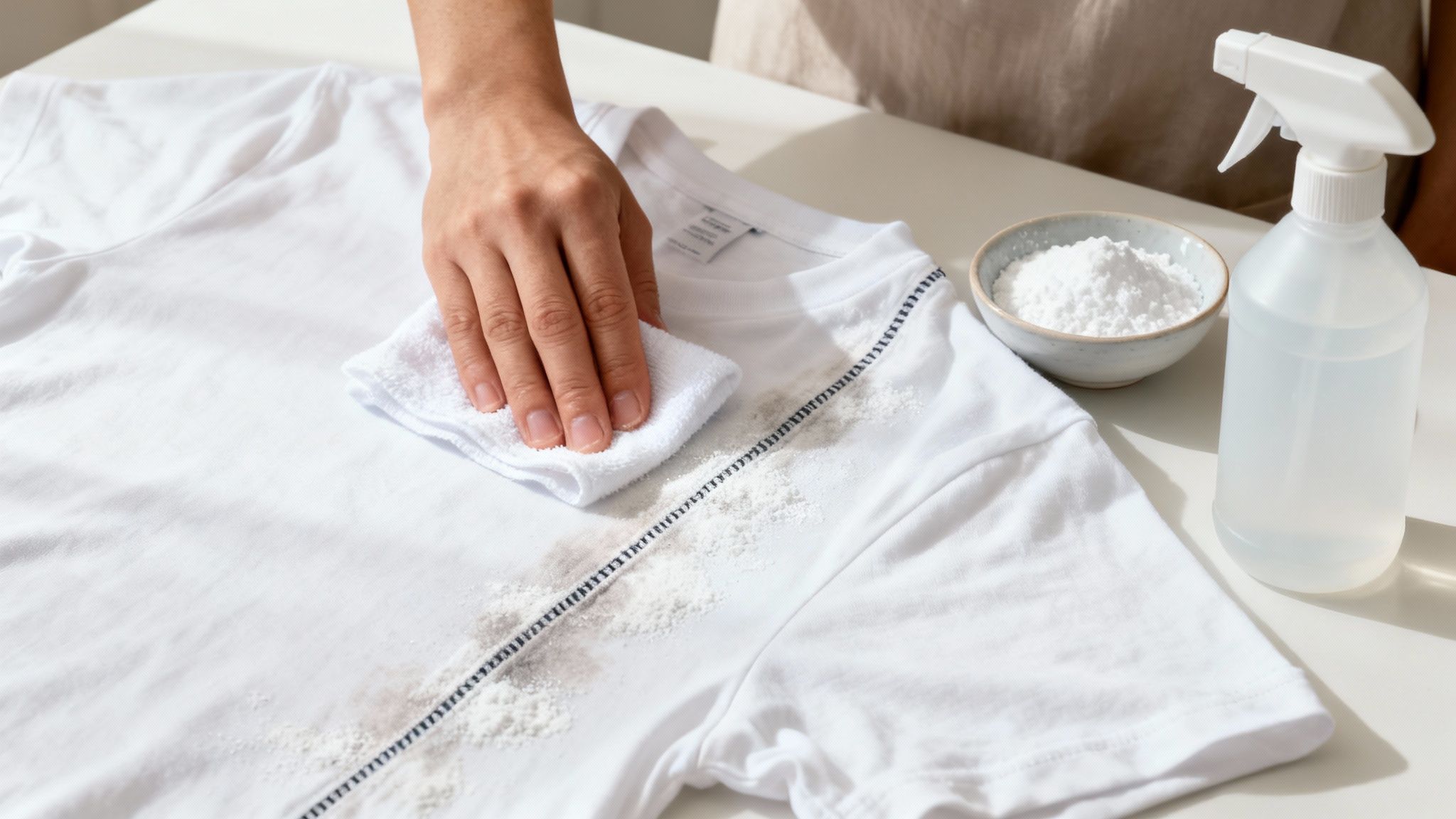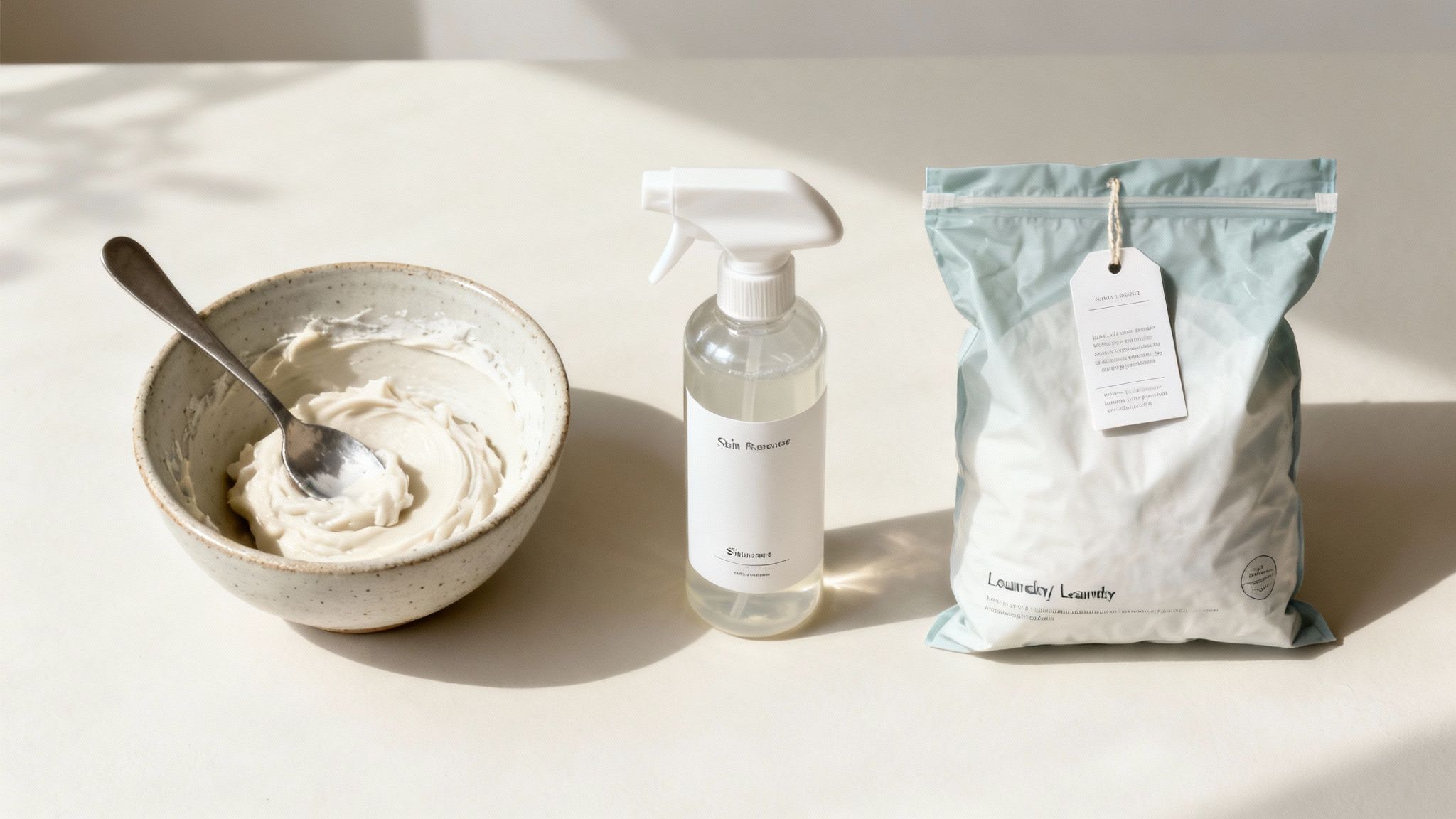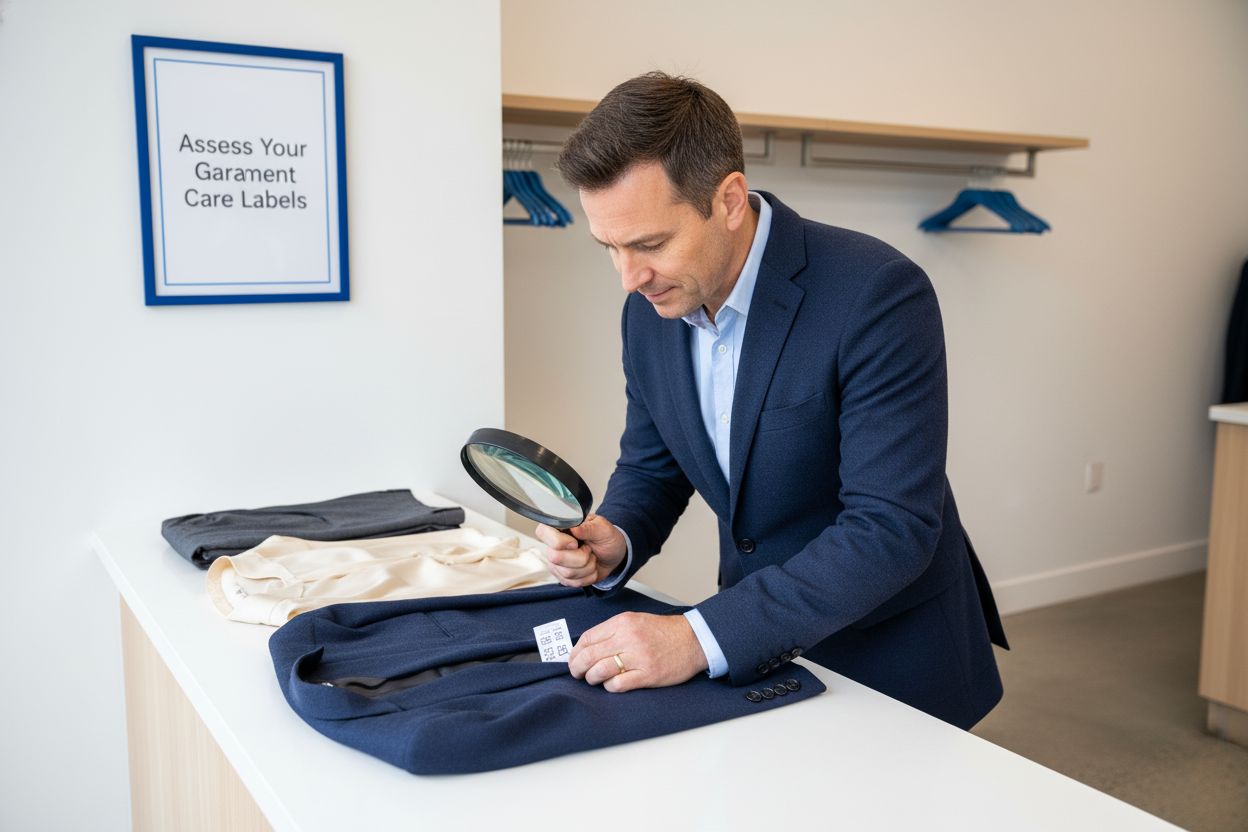How to Get Out Detergent Stains Fast at Home

Just pulled clothes from the washer and spotted those pesky detergent streaks? Here’s a five-minute rescue kit: white vinegar, baking soda and a crisp cloth. It stops dull spots before they settle in for good.
Rescue Fresh Detergent Stains Fast

First, dampen the streaky patch with lukewarm water and blot gently using a white cloth. Avoid scrubbing—just press and lift to coax out loose residues.
Powdery streaks often gather along seams. Stir up a simple vinegar solution—1 part vinegar to 4 parts water—pour it on, and let it rest.
After about 2 minutes, blot again to see if the lines fade. For greasy smudges, switch to baking soda: mix 2 teaspoons of soda with a splash of water into a paste.
Spread the paste over the oily spot and wait 5 minutes before rinsing under running water. Hold it up and check for any chalky bits; if you spot leftovers, a gentle rinse will clear them out.
These quick fixes shine in real life:
- Midweek gym sessions that leave tees streaked
- Rushed loads where too much detergent clings to fabrics
- Hand-washed delicates needing an extra soap-busting boost
Quick Methods Comparison
Here’s a snapshot to help you choose the fastest fix.
A swift response keeps your fabrics fresh and streak-free.
Quick action saves fabrics. Treat fresh stains before they bake in.
For more pocket-sized stain strategies, dive into our full guide: Say Goodbye to Stains Guide
Understand Why Residue Causes Marks
Clothes fresh out of the wash shouldn’t look dull or feel stiff, yet cloudy streaks often tell a different story. In my experience, the usual suspects are hard water minerals that cling to soap or simply cramming too much into the drum.
Then there are those liquid gel pods that refuse to dissolve in cold cycles, leaving tiny beads glued to your workout gear. To decide whether you need to cut back on detergent, crank up the temperature, or add another rinse, pinpointing the root cause is your best first step.
Key Details
- Wash Agitation dictates how well detergent dissolves and disperses.
- Water Hardness influences soap solubility and film formation.
- Detergent Formulas differ in concentration, pH, and dye content.
I often reach for a mineral booster when buildup gets out of hand—check out our guide on borax for laundry stripping to see how it works.
Spotting where soap chooses to linger makes stain removal simpler. For instance, if powdered detergent pools along seams, a quick warm-water agitation can clear residues without calling in extra chemicals.
According to UN-Habitat data, around 2 billion people globally have access to washing machines, driving demand for effective stain removers to handle detergent residues that can cause visible stains or fabric damage. Read the full research about stain remover market insights
Factors That Cause Soap Build Up
When water flows too slowly, undissolved particles collect and stick to fibers. Calcium and magnesium ions in hard water team up with soap to create insoluble scum.
Preventive wash habits go a long way. Follow these quick tips for crystal-clear loads:
- Measure detergent by load size using the dosing guide.
- Select warm water to dissolve powders fully.
- Add an extra rinse cycle when fabrics are bulky.
Key Insight Proper water temperature and correct detergent dose stop most residue marks before they start.
Tuning each variable in your laundry routine ensures every load comes out bright, fresh, and free of streaks.
Treat Different Fabrics With Home Remedies

Detergent stains don’t play fair—what works on cotton can ruin silk. Below, you’ll find targeted home fixes for everything from T-shirts to workout gear.
You’ll see how a 1:4 vinegar soak breathes new life into white cotton, why a baking soda paste is perfect for wool, and how an enzyme spray clears polyester. These tricks have helped folks erase stains on neon tanks and delicate blouses alike.
Laundry care is big business, too. The global stain remover market hit USD 16.86 billion in 2024, according to Data Bridge Market Research.
- Vinegar Pre-Soak (1 part vinegar + 4 parts water)
- Baking Soda Paste (2 tbsp soda + water)
- Enzyme Spray (store-bought or DIY)
“Testing each remedy on a hidden seam ensures color and texture stay intact.”
Cotton And Blended Fabrics
White cotton often shows streaks when detergent builds up in the fibers. Combine 1 cup white vinegar with 4 cups warm water and immerse the stained patch for about 30 minutes. You’ll notice the residue lifting without aggressive scrubbing.
Rinse the area under cool running water, then give it a gentle shake to expel excess liquid. If you’re treating colored blends, dilute to a 1:8 ratio to protect hues. Let garments air dry so you can catch any lingering traces.
Wool And Delicates
Wool sweaters and silk blouses need a gentler touch. Stir 1 tbsp baking soda with just enough water to make a soft paste. Dab it onto the stain and work in small circles with your fingertips.
Allow it to sit for 15 minutes, then rinse under cool water. Press the fabric between two towels—never wring—to remove moisture and keep fibers springy.
- Test on a hidden seam for colorfastness
- Use light pressure to avoid damaging fibers
Protect color and shape by testing first and using gentle motions.
Synthetics And Activewear
Polyester, nylon, and performance blends often trap tiny detergent beads. Shake off any dry granules, then mist an enzyme-based spray directly onto the spot. Give it about 10 minutes to break down soap scum.
For stubborn areas, reapply once more before tossing the item into your regular wash. Always try this on an inconspicuous spot first, and handle activewear delicately to prevent pilling or stretching.
- Shake garment to dislodge particles
- Spray enzyme cleaner and wait
- Rinse under warm water
Prevent Damage And Test
Before diving into any treatment, run a quick test on a hidden seam. Watch for dye bleed after roughly 10 minutes and feel the fabric for any thinning. Adjust soak times or dilution if you notice fading or fiber stress.
- Look for color transfer or fading
- Check for fabric roughness or thinning
- Note your results for next time
Happy laundering.
Compare Removal Techniques For Best Results
Nothing is more frustrating than detergent streaks that refuse to budge. When regular home fixes fall flat, choosing the right treatment becomes a real time-and-energy saver.
I’ve tested everything from pantry staples to lab-formulated sprays and local pickup-and-deliver services. The goal is to match your stain’s stubbornness with your budget and schedule.

I still remember a last-minute rescue: an oxygen-based soak revived a poplin dress just before a family wedding. Another time, a specialist dry-cleaner brought a vintage silk blouse back to life for a gala.
- DIY Home Remedies: Zero cost per use, no shipping fees, gentle on most cotton blends.
- Store-Bought Stain Sprays: Concentrated enzymes or oxygen power with clear dosing instructions.
- Professional Laundry Services: Advanced equipment plus pickup and delivery, perfect for delicates and designer labels.
Below is a quick rundown to help you weigh Cost, Effectiveness, and Fabric Compatibility at a glance.
Technique Effectiveness Comparison
Even the simplest DIY tricks spare your wallet but demand elbow grease and patience. Store-bought sprays tackle spots in minutes, though repeated use adds up. When a cherished piece needs extra care, professional hands can make all the difference.
Commercial Products Overview
Last year I dove into product labels and R&D trends. In 2024 the stain remover market was estimated at USD 37.5 billion, with formulas for detergent residue leading the charge. Learn more about market insights on stain removal.
Key takeaway Commercial formulas promise speed and simplicity but can contain strong chemicals that require precise dosing.
- Easy to store, with clearly marked instructions
- Widely available at supermarkets and drugstores
- Risk of fabric damage if misused
When those marks really won’t quit, you might explore further tips for removing stubborn stains.
Professional Laundry Services Guide
At Columbia Pike Laundry you can book a pickup as soon as tomorrow and skip the scrubbing. Wash-and-fold starts around USD 1.50 per pound, while dry-clean pricing varies by garment.
- Perfect for silks, wool, and embroidered pieces that need extra TLC
- Includes professional pre-treatments that home kits can’t match
- You save time and avoid the frustration of set-in detergent residue
A hybrid strategy often works best: tackle fresh spots with a spray at home, then send gowns and staples to the pros. That way, you stay on budget and never risk ruining your favorite outfits.
Choose the method that fits your routine and watch detergent stains vanish—every time.
Enjoy spotless clothes without the stress.
Build Laundry Routines To Prevent Stains

It only takes a few simple tweaks in your weekly wash pattern to keep detergent streaks at bay. Over time, I’ve learned that precise dosing and sorting by fabric weight really pay off when you empty the drum.
Measuring powder or liquid right at the cap stops extra soap from clinging to seams. For instance, matching the water temperature to each garment’s care label ensures the detergent dissolves fully—no surprises later.
Shaking out shirts and separating bulky items like towels or jackets prevents hidden suds around hems. That way, you’ll spot any lingering soap before you move clothes into the dryer.
Key Takeaway Accurate measuring and matching water temperature drastically reduce detergent streaks.
Essential Dos and Don’ts
- Measure Detergent according to load size with dosing lines or a scoop.
- Add An Extra Rinse when washing heavy items like towels or puffer jackets.
- Choose A Liquid Formula for delicates (silk, wool) to sidestep powder clumps.
- Keep The Drum Sparse so garments tumble freely and rinse thoroughly.
Keeping this approach consistent saves a lot of headaches down the road. It even ties into other tasks, like learning to properly clean your mattress cover.
Flow Of A Clean Routine
Every wash actually starts before the machine even turns on. Glance over seams and hems for hidden suds—they love to hitch a ride in pockets or collar folds.
After the spin cycle, scan for any leftover streaks. A quick cold-water rinse under the faucet can knock those off in seconds.
Mark your calendar: run a hot-water cycle with white vinegar once a month. This flushes out buildup and keeps your washer smelling fresh.
Some folks keep a laundry journal, noting detergent type and load size. I jot down any stubborn residue or fabric quirks—those notes reveal patterns you’d miss otherwise.
Sticking to these rituals means you’ll always pull out crisp, streak-free gear—and dodge those frustrating soap surprises.
Choose When To Seek Professional Help
Even after scrubbing with baking soda paste or a vinegar soak, some detergent stains just won’t budge. When I spot stubborn gray smudges on a silk blouse or streaky marks on cashmere, it’s usually a sign to pause DIY tactics and bring in the pros.
Pushing delicate fabrics too hard can lead to shrinking, color loss, or worse—permanent fiber damage. Knowing when to step back is the first move toward saving your favorite pieces.
When Home Remedies Aren’t Enough
- Fibers Losing Their Luster: Gray or dull patches that persist after several treatments
- Resilient Streaks: Spots that survive extra rinse cycles and vigorous rubbing
- High-End Materials: Silk, wool, or designer blends prone to distortion under harsh scrubbing
Outsourcing tough stains protects fabrics and saves hours of trial and error.
Many local cleaners offer pickup and delivery, making the whole process effortless. Your garments travel from your closet straight into expert hands—no guesswork, no more scrubbing.
Comparing Service Options
- Pricing Models: Compare per-pound rates for wash & fold against per-item dry cleaning fees
- Turnaround Time: Typical windows are 48 hours for laundry and around 3 days for dry cleaning
- Specialized Treatments: Seek out services that handle silk or wool and use eco-friendly solvents
Learn more about professional stain removal in our guide on how professional dry cleaners remove stains.
Now you can slip into each outfit with confidence—stain-free and stress-free.
FAQ
Q How Can I Remove Detergent Stains With Common Household Items?
In most kitchens, you’ll find exactly what you need. A splash of white vinegar or a quick baking soda paste will break down that residue. If you’ve got an enzyme spray, even better—work it into the stain for a minute, rinse well, then let the fabric air dry.
Q Is Hot Water Safe On All Fabrics?
Hot water does a great job blasting away heavy soap streaks, but it can actually set stains on silk and wool. For delicate or protein-based textiles, stick to cool or warm settings to keep fibers happy.
Q How Many Extra Rinse Cycles Should I Run?
I usually recommend one or two extra rinse cycles—that’s enough to clear out leftover suds without wearing out the fabric. Any more than that, and you risk stressing the fibers over time.
Q Will Vinegar Or Baking Soda Harm Dyes?
Most modern dyes handle a short vinegar or baking soda treatment just fine. That said, always test on an inside seam before treating the whole garment. A quick patch-check saves you from surprises.
Quick Rinse Recommendations
- Start with warm water to break down detergent build-up
- Follow up with cool water for a gentle rinse
- Limit extra rinses to two cycles max to protect fabric integrity
Fresh detergent stains are easiest to tackle—address them immediately to prevent them from setting and preserve your clothing’s quality.
Free up your weekend—let Columbia Pike Laundry handle your wash. Book pickup and delivery at Columbia Pike Laundry for spotless clothes without the effort.
Popular Blog Articles

Meet the Author
Daniel Logan didn’t start CPL because he loved laundry. He started it because his family was drowning in time debt, and laundry was one of the biggest weights.
Mornings were chaos with two kids under 5. Evenings felt like catch-up. And weekends? Gone to sorting socks and folding piles.
He knew his story wasn’t unique. So he built a business that gave families like his just a little bit of breathing room one load at a time.
With no laundry experience but deep tech skills, Daniel rolled up his sleeves, doing every job himself while building systems that turned it into a modern laundry service that saves customers time, simplifies their lives, and delivers reliability they can count on.
That’s where CPL began. Not from a playbook, but from pain. From one dad trying to buy back time: for himself, and for every household like his.





